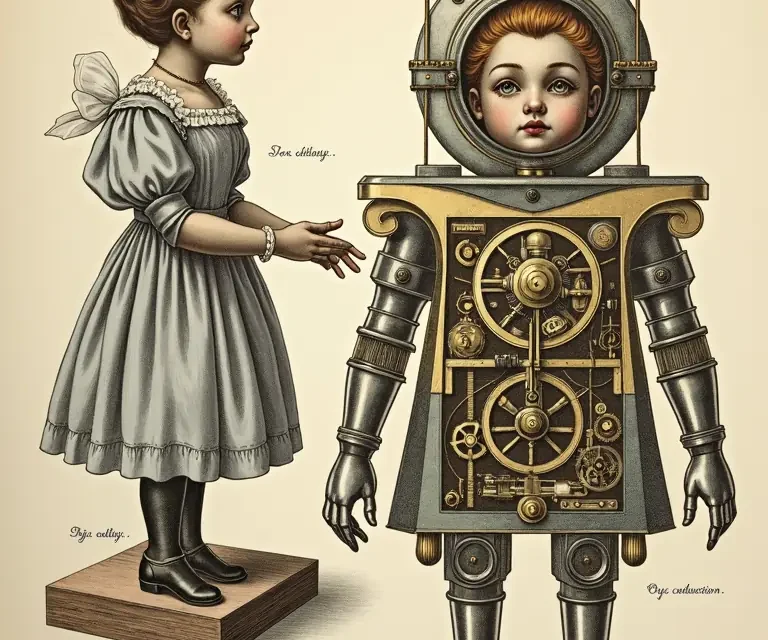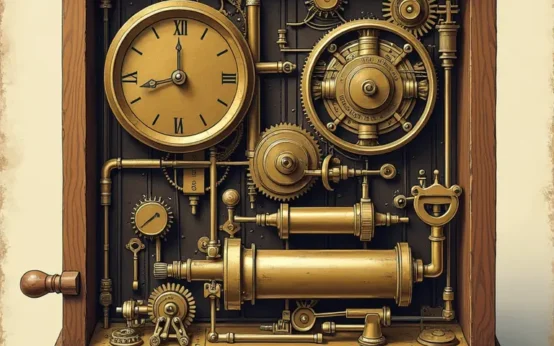For centuries, humanity has been captivated by the idea of creating artificial life. Before the advent of modern robotics and artificial intelligence, this fascination manifested in a breathtakingly intricate form: the automaton. These self-operating machines, often mimicking human or animal behavior, were the pinnacle of mechanical artistry, blending engineering prowess with aesthetic beauty. This article delves into the curious anatomy of antique automata, exploring their mechanisms, historical context, cultural significance, and the lost ingenuity that brought them to life.
A History Woven in Gears
The roots of automata stretch back to antiquity. Ancient civilizations, particularly in Egypt and Greece, crafted rudimentary automated devices, primarily for religious purposes. Heron of Alexandria (c. 10-70 AD), a prolific inventor, documented numerous automatons in his writings, including self-operating temple doors and mechanical theatrical devices. However, these early examples were largely powered by water, wind, or weight-driven systems, and their complexity was limited.
The true flowering of automata occurred during the medieval period, particularly in the Islamic world. Al-Jazari (1136-1206), a polymath and inventor, is often considered the “father of robotics.” His Book of Knowledge of Ingenious Mechanical Devices details a remarkable array of automata, including musical robots, automated fountains, and even a programmable humanoid robot. These devices relied on sophisticated cam and gear systems, showcasing a level of engineering sophistication far ahead of their time.
The Renaissance saw the rediscovery of classical texts and a renewed interest in mechanical invention. Leonardo da Vinci (1452-1519) designed several automata, including a mechanical knight capable of sitting, standing, and moving its arms – though whether these designs were ever fully realized remains debated. Throughout the 17th and 18th centuries, Europe became the epicenter of automaton creation. French clockmakers, in particular, excelled in crafting intricate and elaborate automata, often incorporating them into clocks, musical instruments, and decorative objects.
The Mechanical Heart: Unpacking the Mechanisms
At the heart of every automaton lies a complex network of mechanical components. Understanding these components is crucial to appreciating the ingenuity of their creators.
Gears: The Foundation of Motion
Gears are the most fundamental element of an automaton. They transmit rotational force and change speed and direction. Different types of gears – spur gears, bevel gears, worm gears – were employed to achieve specific movements. The precise arrangement and ratio of gears determined the automaton’s speed, power, and the complexity of its motions. The skill in gear cutting was paramount; even slight imperfections could lead to malfunction. The evolution of gear technology, including the development of more precise cutting tools, directly influenced the sophistication of automata.
Cams and Followers: Translating Rotation into Linear Motion
While gears provide rotational motion, cams and followers are essential for converting this rotation into linear or reciprocating movements. A cam is a rotating or sliding piece with an irregular shape, while a follower rides on the cam’s surface. As the cam rotates, the follower moves up and down or back and forth, driving various parts of the automaton. Cams were used extensively to create lifelike movements in automata, such as the flapping of wings, the nodding of heads, and the movement of limbs. The precision required to create effective cams is akin to the detailed engineering found in other historical artifacts.
Escapements: Regulating Time and Motion
In automata designed to perform repetitive actions or simulate time-based movements, escapements played a vital role. Originally developed for clocks, escapements regulate the release of energy from a power source (like a weight or spring), allowing for controlled and consistent motion. The design of the escapement directly affected the accuracy and smoothness of the automaton’s movements. The relationship between escapements in automata and clocks highlights a shared technological ancestry.
Power Sources: Winding the Machine
Antique automata were powered by various sources. Early examples relied heavily on weights and falling objects. Later, spring-driven mechanisms became more common, offering a more compact and portable power source. Clockwork mechanisms, utilizing a coiled spring and a series of gears, were particularly popular. The winding key, often intricately decorated, was the interface between the operator and the automaton’s mechanical heart. The duration of the automaton’s operation depended on the size of the spring and the efficiency of the mechanism.
The Automaton’s ‘Brain’: The Drum and Pins
Perhaps the most ingenious element of many automata was the use of a rotating drum with strategically placed pins. This drum acted as a rudimentary program, controlling the sequence and timing of movements. As the drum rotated, the pins engaged with a mechanism, triggering specific actions. By altering the arrangement of pins, the automaton’s behavior could be reprogrammed, allowing for a degree of flexibility and customization. This is arguably the earliest form of programmable automation.
Glamour and Spectacle: The Aesthetics of Automation
Antique automata were not merely mechanical marvels; they were also works of art. Their creators lavished attention on their appearance, crafting elaborate costumes, lifelike features, and ornate casings.
Materials and Craftsmanship
Automata were constructed from a wide range of materials, including brass, steel, iron, wood, ivory, and precious stones. The choice of materials depended on the automaton’s function, cost, and intended audience. Skilled artisans – clockmakers, goldsmiths, jewelers, and painters – collaborated to create these intricate machines. The meticulous craftsmanship evident in their construction speaks to the dedication and artistry of their creators.

Theatricality and Performance
Many automata were designed for public display, often showcased in exhibitions, fairs, and private collections. They were presented as theatrical spectacles, captivating audiences with their lifelike movements and enchanting performances. Some automata were designed to play musical instruments, write letters, or even tell fortunes. The element of surprise and the illusion of life were central to their appeal.
The Rise of the ‘Automaton Maker’
The 18th century saw the emergence of professional automaton makers, such as Jacques de Vaucanson and the Jaquet-Droz family. These artisans established workshops and produced automata on a commercial scale. Their creations were highly sought after by royalty, nobility, and wealthy collectors. The Jaquet-Droz automata, in particular, are renowned for their complexity and artistry. The profession of an automaton maker is just one example of a specialized skill that has largely disappeared over time.
Notable Automata and Their Stories
The Digesting Duck (Jacques de Vaucanson, 1739)
Perhaps the most famous automaton of the 18th century was Jacques de Vaucanson’s Digesting Duck. This mechanical duck was capable of flapping its wings, quacking, eating grains, and even defecating – a feat that astonished contemporary observers. While the duck’s digestive system was largely a clever illusion, it demonstrated Vaucanson’s mastery of mechanical engineering.
The Writer (Henri Maillardet, early 19th century)
Henri Maillardet’s automaton, known simply as “The Writer,” was a remarkable feat of engineering. This mechanical boy was capable of writing letters and drawings in French, guided by a complex program encoded on a rotating cylinder. The automaton’s movements were incredibly lifelike, and its ability to produce legible handwriting was truly astonishing.
The Draughtsman-Automaton (Jaquet-Droz, 1770s)
The Jaquet-Droz family created several remarkable automata, including the Draughtsman-Automaton. This mechanical artist was capable of drawing intricate pictures, guided by a series of cams and gears. The automaton’s ability to create original artwork was a testament to the ingenuity of its creators.
The Decline and Revival of Automata
The popularity of automata began to decline in the 19th century with the rise of industrialization and the development of more efficient manufacturing processes. Mass-produced goods became more accessible, diminishing the appeal of handcrafted automata. However, interest in automata experienced a revival in the 20th and 21st centuries, driven by a renewed appreciation for mechanical artistry and the history of technology.
Today, antique automata are highly prized by collectors and museums. They offer a glimpse into a bygone era of mechanical ingenuity and artistic craftsmanship. Contemporary artists and engineers continue to be inspired by the legacy of automata, creating new and innovative robotic creations.
The Legacy of Lost Ingenuity
The study of antique automata is not merely a historical exercise. It provides valuable insights into the evolution of technology, the interplay between art and engineering, and the enduring human fascination with creating artificial life. The skills and knowledge required to build these intricate machines have largely been lost to time, making them all the more remarkable. The precision demanded in automaton construction mirrors the meticulous standards of measurement in other historical crafts.
Furthermore, the principles underlying automata – gear systems, cam mechanisms, programmable control – laid the foundation for modern robotics and automation. The dream of creating intelligent machines, which fueled the creation of automata centuries ago, continues to drive innovation in the 21st century.
The curious anatomy of antique automata is a testament to human creativity, ingenuity, and the enduring quest to understand and replicate life itself. These mechanical marvels, with their gears, glamour, and lost ingenuity, continue to captivate and inspire us today.


 The Surprisingly Consistent Science of Vintage Sewing Machine Mechanisms – Gears, Innovation & the Rise of Home Fashion
The Surprisingly Consistent Science of Vintage Sewing Machine Mechanisms – Gears, Innovation & the Rise of Home Fashion  The Surprisingly Consistent Science of Antique Clockwork Music Boxes: Gears, Cylinders & Melodic Memory
The Surprisingly Consistent Science of Antique Clockwork Music Boxes: Gears, Cylinders & Melodic Memory